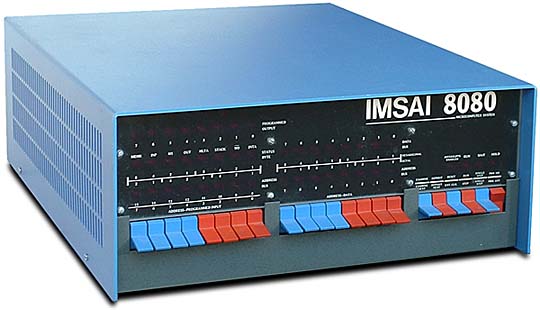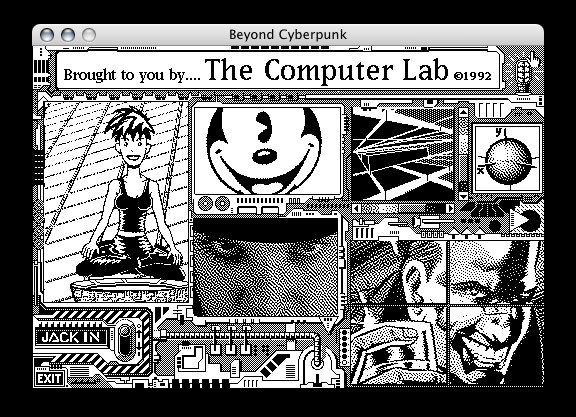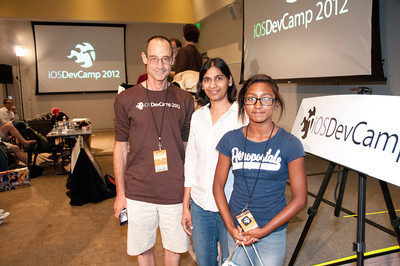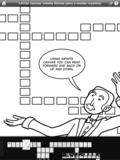Over my lifetime I have encountered a number of “tools for ignition” — a phrase which I use to describe innovative products that have empowered people and created movements. On the 25th anniversary of Hypercard’s introduction, I want to take a look back at some of these tools.
BASIC (1976)
In 1976 I encountered my first tool for ignition: Bill Gate’s MicroSoft BASIC running on the IMSAI 8080. There was no ROM on this computer, so you had to load a boot program using the front panel switches you see above. This program would then allow us to use a paper-tape reader, from which we would load BASIC.

At 15 it wasn’t the hardware that got me excited, it was the idea of software — that you could take a creative idea that was in your mind and then craft that idea into a reality.
My passion of the moment was French (the daughter of my French teacher was quite cute), so my first program was an attempt to teach my computer to translate between French to English.
Alas, I utterly failed in my first attempt, limited by the 4K RAM, and I had no more luck working in 8K. But my failure didn’t matter in the long term — it inspired a career creating tools that nurture creative passions.
BBS (1978)
My next experience with a tool for ignition was Ward Christensen’s CBBS, the first electronic bulletin board system. Within months of its release in 1978, there were BBSs sprouting up all over the United States. I dialed a long-distance number, logged into a BBS, and discovered many passionate people wanting to share their experience — not only computer, but life. For the first time, I experienced computer software as a tool for human interaction, not only as a utility for running a program.
By this point I was working after school part-time in a microcomputer store, so I scavenged up an old S100 computer and a used modem and made available a small BBS in my hometown. No longer having to pay long-distance charges, at 17 I found myself at the center of an online community. This experience proved invaluable — indeed, today I credit my success to the skills I acquired in facilitating online conversations and growing communities that share common interests.
MacPaint (1984)
Six years passed, and personal computers started to become more common in people’s workplaces and homes. Unlike the IMSAI 8080, they now had screens and keyboards, and they made great text processors and data crunchers, but they weren’t particularly “sexy”. On January 24, 1984, the first Mac was released, and I dropped into my local computer store to see what it was all about. The original 128K Mac was “different”, as Apple’s later marketing campaign put it, but also clunky in appearance.
However, my jaw dropped when I saw Bill Atkinson’s (MacPaint) [http://en.wikipedia.org/wiki/MacPaint]. The simple elegance of this software that allowed me to draw and express myself graphically on a computer screen with a mouse was what sold me on the Mac, not the hardware.
By this point, I was making my living doing software development. I wasn’t an artist myself, but I dropped everything to hire some artist friends to start drawing on the Mac. I would start a clip-art company, I thought, not knowing that too many other people had the same idea. So I considered how I could build on my prior experience with computers and take advantage of this new platform. I wrote a bootstrap app (in BASIC!) to take advantage of the Mac’s serial port and enable the user to download a more serious terminal app. Later I published the first Macintosh BBS Mouse Exchange BBS, and the first graphical interface to a BBS.
Open Standards (1985)
Later in 1985 I experienced my next tool for ignition — though “tool” may seem an odd term to describe something so abstract — open standards. I had recently parlayed my facilitation skills into a paid position as a CompuServe sysop, and because of my bootstrap app, the Mac BBS that I published, I participated in my first open standard, called MacBinary, a way of encoding early Mac applications so that they could be transferred online.
This was my first experience working with other engineers to facilitate the creation of something quite ephemeral and hard to describe to non-programmers. Not quite software, but a language between software, enabling them to share information and work together despite being written by different people in different programming languages.
In the open standards community I learned the value of some principles that I use daily: “Ship early and often”, “Fail fast”, “Perfection is the enemy of the good”, “Be conservative in what you send, liberal in what you accept”, etc.
My experience with MacBinary motivated me to continue participating in open standards efforts over the years, leading to what I consider my biggest success as a facilitator and co-author of the SSL Standard, the world’s most widely deployed security standard. What drew me to SSL (as opposed to competitive security standards offered by others) was that it could be used for much more than just internet transactions. It could be used to secure a variety of conversations between people. Using the power of the RFC editor, I reserved ports for secure SMTP, IMAP, POP, IRC, FTP and more. I got some flack for this as internet ports are considered a limited resource, but it turned out well when SSL and these ports were used twenty years later during the Arab Spring to help ensure freedom of communication between protesters.
HyperCard (1987)
Twenty-five years ago this month — August 11,1987 at MacWorld — I encountered Bill Atkinson’s Hypercard. Hard to describe but truly a tool for ignition if there ever was one, Hypercard has been variously called a “stack of virtual cards, “hypermedia system”, “programming for the masses”. Bill Atkinson described it as “a construction kit that lets normal people make their own software”.
I was already programming in a variety of programming languages, but like MacPaint before it, HyperCard drew me in because of its elegance and its ability to allow non-programmers to participate in the creation of software. You can see the most complex HyperCard stack I ever wrote, running a TV studio at Apple Computer, in the first 40 seconds of this 1990 video feature on HyperCard.
HyperCard empowered a whole generation of passionate, creative people who otherwise never would have had the chance to share their ideas and visions with the world. I saw thinkers I admired begin to express their thoughts through software. Artists and designers loved that they could bring their language of imagery to life. Children who never had programmed before would start by drawing on some “cards”, add buttons, show their friends, get excited and ultimately start on the path to learn how to express oneself through software. Amazing stories were told: some of my favorites were “If Monks Had Macs”, “Spaceship Warlock”, “Beyond Cyperpunk” and ultimately Myst.

HyperCard had a profound impact beyond those who discovered and used it on the Mac. Many do not know that Tim Berners-Lee, the creator of the World Wide Web, was inspired by HyperCard. Ward Cunningham, investor of the first Wiki also credits it for inspiration.
HyperCard’s 25th Anniversary
In celebration of Hypercard’s 25th anniversary, we asked Bill Atkinson to come to the Hillside Club in Berkeley to speak. In advance of this, I asked my colleagues and friends to share what inspired them about HyperCard by posting to blogs and twitter using the hashtag #HyperCard25th. Here are some of my favorite appreciations:
Lion Kimbro @LionKimbro HyperCard showed me that writing code can be like molding clay into a sculpture, forever changing my idea of programming.
debs @debs Happy 25th Bday HyperCard. You introduced me to the empowering world of computers as creativity..b4 you it was intimidating
Sean McBride @smcbride HyperCard got me started with computers and programming. Made a card catalog for my library in grade school. Thanks!
Richard Ford @rvf It uniquely let me develop and share tools to solve problems and teach in minutes rather than days. Happy 25th Hypercard!
AnthroPunk @AnthroPunk Apple’s The Virtual Museum was stack. QT Beta-VM had JPL MARS data for 1st MULTIMEDIA MARS FLYOVER EVER!
Chris Heuer @chrisheuer wow, can’t believe it’s been 25 yrs! HyperCard gave me an innate understanding if hyperlinked computing, leading me here…
Jason Sims @stormchild HyperCard was way ahead of its time. It influenced the creation of the WWW, and powered the classic game Myst.
Grant Neufeld @grant I have seen nothing before or since that can top HyperCard for fun and ease of getting into programming. It changed my world.
John McDaid @jmcdaid Happy birthday, #HyperCard25th a still-unequaled tool that enabled a generation of writers to do amazing things. Thank, you Bill Atkinson.
Jon Pugh @thejonpugh I first saw WildCard when Chuck showed up at A32 user group meeting with a bootleg beta. It was love at first sight.
Danny Ngan @poopoorama Wow, HyperCard is 25 years old! It was the first app I used for animation and interactive media back in 1989.
Andrew Stone @twittelator 25 years ago I was so inspired by Bill Atkinson’s demo of HyperCard, I dropped everything and became a Mac programmer
John Stack @johnstack Happy #Hypercard25th Easy for newbies! Gave me hope that I could get something done and I did!
Peter Thoeny @peterthoeny Häppy 25th Birthday! Today is HyperCard’s birthday. It inspired wikis and TWiki.
We are connected @MarkDilley Happy birthday #HyperCard25th !! Without you there would be no #WikiBirthday !!
David Weinberger @dweinberger 25 yrs ago I was at the HyperCard launch, greatest I’d ever seen. But HyperCard + Net != The Web
Sean Parent @SeanParent HyperCard turns 25! The natural language structure in HyperCard had a big influence on Photoshop Actions. Thanks Bill!
Geppy @geppyp Happy birthday Hypercard!!! This weekend is the 25th Anniversary of HyperCard, my first step in the mac programming world!
Worth Godwin @windowsmachowto I discovered HyperCard when setting up a Mac lab for school credit in 1990. Thought it was amazingly cool & kinda miss it.
Alex Seville @alex_seville Coming up with ideas, and easily implementing them with Hypercard certainly influenced my lifelong interest in programming
Jason McIntosh @JmacDotOrg I used Hypercard while employed at UMaine to make interactive presentations for students & faculty. My first programming job.
Kristee Rosendahl @SmartGardener1 HyperCard had seismic impact on how we envisioned/designed “multimedia” at the Apple Multimedia Lab back in those early days.
Bryan Stearns @bryanstearns Standing on the shoulders of giants… like you do
Clark Quinn @Quinnovator HyperCard played big part in my work and thinking: learning games and performance support tools
Scott Draves @spot Blew my mind and absorbed many hours, yes we had it back in the 80s. Now remember the man who made it
Infinite Canvas (2012)
It is the mindset expressed in three more quotes from #HyperCard25th neatly sum up what inspired me to create a new tool for ignition — Infinite Canvas.
Mike Sugarbaker @misuba It’s HyperCard’s 25th birthday. We still haven’t seen its equal as far as I’m concerned. I hope we do.
David HM Spector @dhmspector HyperCard let me do fast prototypes & lots of flexible mini-apps for my clients; great tool! So Apple, HC for iPad? Please?
Howard Greenstein @howardgr Hypercard – An Amazing Tool I Still Miss #HyperCard2th
Since 2007 I have been running a participatory event, originally called iPhoneDevCamp, but now called iOSDevCamp. Over the course of a weekend we get ~400-500 people to stay up late and show their effort in a Hackathon. At the last one 71 new iPhone and iPad apps were created in 36 hours, 29 of which were open source.
iOSDevCamp appeals to me because it is creative ignition in action — it was founded on twitter, organized as an online community, supports the ideals of collaboration and nutures passionate creative people. In recent years I’ve been quite proud of the diversity of the conference, with designers, artists, women, young adults and even children participating.

However, today the barriers between being a spectator and becoming a creator are huge. It is increasingly hard for a new user to create a good-looking web page. The skills required to create an iPhone or iPad app are quite intimidating. I have had many designers show up at iOSDevCamp whom I was unable to match with a coder because they lacked the most basic understanding of the principles of interactivity. Sadly, I was unable to facilitate their full participation.
So at iOSDevCamp 2010 I started Infinite Canvas, based on the principles of what inspired me about HyperCard. This tool needed to allow artists, designers, photographers, children to easily experience creating interactive stories and experiences. It needed to not only be easy to use, but also easy to share — no gatekeepers saying “This isn’t good enough”. It needed to support discoverability, where those new to the language of interactivity could learn and advance their skills to ultimately create quite sophisticated experiences. And it needed to take advantage of the new computing experiences that the iPad offers — portability, touchability — advantages that even the lightest laptop was never quite able to match.

The first version of Infinite Canvas iPad app, initially a viewer-only version, was approved and released Friday in the Apple App Store, the day before HyperCard’s anniversary. There is a library of example canvases available which can be downloaded for free using the app. Users will be able to create their own canvases in the near future when the Infinite Canvas authoring tool makes its debut.
We still have a long way to go to offer all that HyperCard offered. We support both simple tiles and HTML5 tiles, but the learning bridge between them is huge. But in the spirit of “Ship early and often”, “fail fast”, and “perfection is the enemy of the good” we wanted to make this tool available now.
Bill Atkinson once explained what motivated him to create HyperCard: “A lot of people are going to get opened up, enabled, empowered to control their computer. That’s really what we’re trying to do.” And that is exactly what we are trying to do on the iPad with Infinite Canvas.
Life With Alacrity
© Christopher Allen

